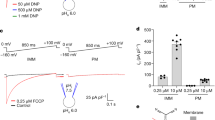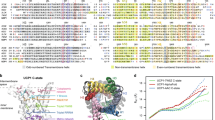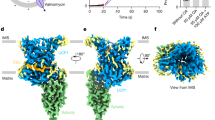Abstract
Uncoupling proteins (UCPs) are thought to be intricately controlled uncouplers1,2,3 that are responsible for the futile dissipation of mitochondrial chemiosmotic gradients, producing heat rather than ATP. They occur in many animal and plant cells4,5,6,7,8,9 and form a subfamily of the mitochondrial carrier family10. Physiological uncoupling of oxidative phosphorylation must be strongly regulated to avoid deterioration of the energy supply and cell death, which is caused by toxic uncouplers. However, an H+ transporting uncoupling function is well established only for UCP1 from brown adipose tissue2,8,9,11, and the regulation of UCP1 by fatty acids, nucleotides and pH remains controversial2,12,13,14. The failure of UCP1 expressed in Escherichia coli inclusion bodies to carry out fatty-acid-dependent H+ transport activity inclusion bodies15 made us seek a native UCP cofactor. Here we report the identification of coenzyme Q (ubiquinone) as such a cofactor. On addition of CoQ10 to reconstituted UCP1 from inclusion bodies, fatty-acid-dependent H+ transport reached the same rate as with native UCP1. The H+ transport was highly sensitive to purine nucleotides, and activated only by oxidized but not reduced CoQ. H+ transport of native UCP1 correlated with the endogenous CoQ content.
This is a preview of subscription content, access via your institution
Access options
Subscribe to this journal
Receive 51 print issues and online access
$199.00 per year
only $3.90 per issue
Buy this article
- Purchase on Springer Link
- Instant access to full article PDF
Prices may be subject to local taxes which are calculated during checkout




Similar content being viewed by others
References
Nicholls, D. G. & Locke, R. M. Thermogenic mechanisms in brown fat. Physiol. Rev. 64, 1–64 (1984).
Klingenberg, M. & Huang, S.-G. Structure and function of the uncoupling protein from brown adipose tissue. Biochim. Biophys. Acta 1415, 271–296 (1999).
Nedergaard, J. & Cannon, B. The uncoupling portein thermogenin and mitochondrial thermogenesis. New Comp. Biochem. 23, 385–420 (1992).
Fleury, C. et al. Uncoupling protein-2: a novel gene linked to obesity and hyperinsulinemia. Nature Genet. 15, 269–272 (1997).
Boss, O. et al. Uncoupling protein-3: a new member of the mitochondrial carrier family with tissue-specific expression. FEBS Lett. 408, 39–42 (1997).
Mao, W. et al. UCP4, a novel brain-specific mitochondrial protein that reduces membrane potential in mammalian cells. FEBS Lett. 43, 326–330 (1999).
Laloi, M. et al. Plant cold-induced uncoupling protein. Nature 389, 135–136 (1997).
Boss, O., Muzzin, P. & Giacobino, J. P. The uncoupling proteins, a review. Eur. J. Endocrinol. 139, 1–9 (1998).
Ricquier, D. & Bouillaud, F. The uncoupling protein homologues: UCP1, UCP2, UCP3, StUCP and AtUCP. Biochem. J. 345, 161–179 (2000).
Aquila, H., Link, T. A. & Klingenberg, M. Solute carriers involved in energy transfer of mitochondria form a homologous protein family. FEBS Lett. 212, 1–9 (1987).
Lin, C. S. & Klingenberg, M. Characteristics of the isolated purine nucleotide binding protein from brown fat mitochondria. Biochemistry 21, 2950–2956 (1982).
Jezek, P., Orosz, D. E., Modriansky, M. & Garlid, K. D. Transport of anions and protons by the mitochondrial uncoupling protein and its regulation by nucleotides and fatty acids. A new look at old hypotheses. J. Biol. Chem. 269, 26184–26190 (1994).
Gonzalez-Barroso, M. M., Fleury, C., Bouillaud, F., Nicholls, D. G. & Rial, E. The uncoupling protein UCP1 does not increase the proton conductance of the inner mitochondrial membrane by functioning as a fatty acid anion transporter. J. Biol. Chem. 273, 15528–15532 (1998).
Matthias, A., Jacobsson, A., Cannon, B. & Nedergaard, J. The bioenergetics of brown fat mitochondria from UCP1-ablated mice. Ucp1 is not involved in fatty acid-induced de-energization (“uncoupling”). J. Biol. Chem. 274, 28150–28160 (1999).
Echtay, K. S. et al. Regulation of UCP3 by nucleotides is different from regulation of UCP1. FEBS Lett. 450, 8–12 (1999).
Murdza-Inglis, D. L. et al. Functional reconstitution of rat uncoupling protein following its high level expression in yeast. J. Biol. Chem. 266, 11871–11875 (1991).
Arechaga, I. et al. Cysteine residues are not essential for uncoupling protein function. Biochem. J. 296, 693–700 (1993).
Echtay, K. S., Bienengraeber, M. & Klingenberg, M. Mutagenesis of the uncoupling protein of brown adipose tissue. Neutralization of E190 largely abolishes pH control of nucleotide binding. Biochemistry 36, 8253–8260 (1997).
Bathgate, B., Freebairn, E. M., Greenland, A. J. & Reid, G. A. Functional expression of the rat brown adipose tissue uncoupling protein in Saccharomyces cerevisiae. Mol. Microbiol. 6, 363–370 (1992).
Jaburek, M. et al. Transport function and regulation of mitochondrial uncoupling proteins 2 and 3. J. Biol. Chem. 274, 26003–26007 (1999).
Huang, S.-G. & Klingenberg, M. Fluorescent nucleotide derivatives as specific probes for the uncoupling protein: thermodynamics and kinetics of binding and the control by pH. Biochemistry 34, 349–360 (1995).
Winkler, E., Wachter, E. & Klingenberg, M. Identification of the pH sensor for nucleotide binding in the uncoupling protein from brown adipose tissue. Biochemistry 36, 148–155 (1997).
Skulachev, V. P. Fatty acid circuit as a physiological mechanism of uncoupling of oxidative phosphorylation. FEBS Lett. 294, 158–162 (1991).
Brustovetsky, N. & Klingenberg, M. The reconstituted ADP/ATP carrier can mediate H+ transport by free fatty acids, which is further stimulated by mersalyl. J. Biol. Chem. 269, 27329–27336 (1994).
Winkler, E. & Klingenberg, M. Effect of fatty acids on H+ transport activity of the reconstituted uncoupling protein. J. Biol. Chem. 269, 2508–2515 (1994).
Fiermonte, G., Walker, J. & Palmieri, F. Abundant bacterial expression and reconstitution of an intrinsic membrane transport protein from bovine mitochondria. Biochem. J. 294, 293–299 (1993).
Kaplan, R. S. High-level bacterial expression of mitochondrial transport proteins. J. Bioenerg. Biomembr. 28, 41–47 (1996).
Schroers, A., Burkovski, A., Wohlrab, H. & Kramer, R. The phosphate carrier from yeast mitochondria. Dimerization is a prerequisite for function. J. Biol. Chem. 273, 14269–14276 (1998).
Kowaltowski, A. J., Costa, A. D. & Vercesi, A. E. Activation of the potato plant uncoupling mitochondrial protein inhibits reactive oxygen species generation by the respiratory chain. FEBS Lett. 425, 213–216 (1998).
Walter, L. et al. Three classes of ubiquinone analogs regulate the mitochondrial permeability transition pore through a common site. J. Biol. Chem. 275, 29521–29527 (2000).
Acknowledgements
We thank K. Beyer for the NMR measurements. This work was supported by a grant from the Deutsche Forschungsgemeinschaft.
Author information
Additional information
Institute of Physiological Chemistry, University of Munich, Schillerstrasse 44, Munich, D-80336, Germany
Rights and permissions
About this article
Cite this article
Echtay, K., Winkler, E. & Klingenberg, M. Coenzyme Q is an obligatory cofactor for uncoupling protein function. Nature 408, 609–613 (2000). https://doi.org/10.1038/35046114
Received:
Accepted:
Issue Date:
DOI: https://doi.org/10.1038/35046114
This article is cited by
-
UCP2 and pancreatic cancer: conscious uncoupling for therapeutic effect
Cancer and Metastasis Reviews (2024)
-
Increasing Nrf2 Activity as a Treatment Approach in Neuropsychiatry
Molecular Neurobiology (2021)
-
New pathogenic variants in COQ4 cause ataxia and neurodevelopmental disorder without detectable CoQ10 deficiency in muscle or skin fibroblasts
Journal of Neurology (2021)
-
Ccr7 null mice are protected against diet-induced obesity via Ucp1 upregulation and enhanced energy expenditure
Nutrition & Metabolism (2019)
-
Reduction in the levels of CoQ biosynthetic proteins is related to an increase in lifespan without evidence of hepatic mitohormesis
Scientific Reports (2018)
Comments
By submitting a comment you agree to abide by our Terms and Community Guidelines. If you find something abusive or that does not comply with our terms or guidelines please flag it as inappropriate.



